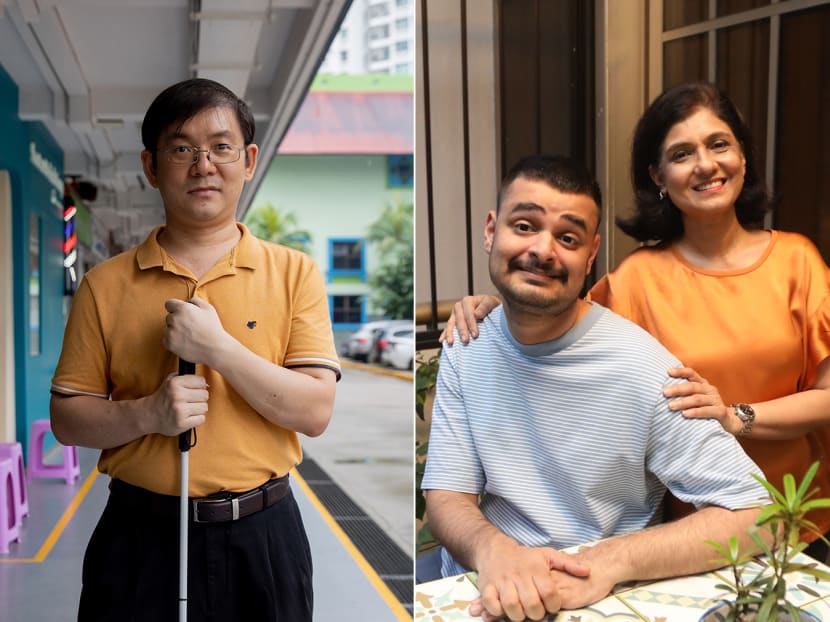Strides made towards an inclusive S'pore but more can be done, say disabled community and experts
SINGAPORE — Ms Judy Wee, 60, a wheelchair user with congenital deformity of limbs, can recall several incidents when she got off at an MRT station only to find that the lift at the platform was faulty, so had to take the train back to the previous station, disembark there and wheel herself to her destination.

Mr Chong Kwek Bin (left) is former head of employability and employment and advocacy at the Singapore Association of the Visually Handicapped, while Mrs Anu Sethi (right) is a full-time caregiver to her 25-year-old autistic son.
- Experts and the disabled community remarked that Singapore has come a long way in making the nation more inclusive for the disabled
- Yet, there are calls to go further in providing greater accessibility and job opportunities
- The disabled and their caregivers are calling for a deeper understanding of various disabilities
- Observers welcomed the Government’s aim to raise the proportion of people with disabilities employed, but called for careful balance of community and workplace interests
SINGAPORE — Ms Judy Wee, 60, a wheelchair user with congenital deformity of limbs, can recall several incidents when she got off at an MRT station only to find that the lift at the platform was faulty, so she had to take the train back to the previous station, disembark and wheel herself to her destination.
“That is okay when the other station is not too far away, but in many instances, it's actually quite an impossible thing to do,” said Ms Wee, the executive director of the Muscular Dystrophy Association (Singapore). She wishes there would be more than one lift at MRT stations to connect the platform to the concourse area.
Meanwhile, Mrs Anu Sethi, a full-time caregiver of a 25-year-old autistic son, said the young man has been matched by well-meaning organisations to unsuitable jobs with noisy environments, such as in a laundry and warehouse, which made him irritable and led to occasional meltdowns.
Eventually she found a job for him on her own, in a company that sells rehabilitation equipment for seniors.
These are just two examples of how, despite progress made over the years to make Singapore a more inclusive society, members of the disabled and special needs community say much more still needs to be done.
This includes making the built environment more inclusive or inculcating a better understanding of the community's needs when developing and executive well-meaning initiatives.
To be fair, experts and people from within the disabled and special needs community agree that Singapore has come a long way, pointing to the high level of awareness among the general public about inclusivity and strong political will to keep making improvements.
The latest such effort, the Enabling Masterplan 2030 launched on Aug 17, contains 29 recommendations to help the disabled be active and contributing members of society, including suggestions on how to enhance educational and transport infrastructure.
PROGRESS HAS BEEN STEADY, BUT COULD BE FASTER
Disability researcher Victor Zhuang said the past decade has seen a "heartening" pace in efforts to improve inclusivity across Singapore.
“We have SG Enable being set up in 2013, which allowed for a focal point, a key agency to mobilise efforts. And from there you see innovative solutions and initiatives, milestones which are key highlights in how we have tackled the question of inclusion.”
SG Enable is the main government-linked agency for persons with disabilities and falls under the Ministry of Social and Family Development.
Mr Zhuang also cited the example of Enabling Village, an inclusive space set up in Redhill on 2015, seeking to connect people with disabilities with society and the recently launched Enabling Academy, which looks to promote lifelong learning in skills and education for disabled people as “key milestones”.
Mr JR Karthik, chief executive officer of social service agency Awwa, similarly highlighted improved efforts at involving the disabled in the community, saying that there has been an increase in social awareness.
He noted that efforts to become more inclusive have increased in quality and have “matured along with society.”
He added that the continuous advocacy and collective effort by social service agencies, caregivers and persons with disabilities themselves did effect an “obvious mindset shift”.
However, some feel that more can be done to cater to the disabled at a faster pace.
Mr Kenneth Mah, vice-president of the Rare Disease Society, said that much has progressed in the disability landscape since 2007.
“The roadmap of an individual who requires more needs has been mapped out, resources are much more well-coordinated, parents and families are definitely more well supported emotionally with various support groups made available, especially for the caregivers,” he said.
Still, he said there are challenges, such as limited resources, government policies which take years to implement and only a few advocating for the needs of families with special needs.
He also pointed out that several policies designed to provide support for the disabled use income per capita to determine eligibility, which means that persons with disabilities are not able to benefit from the scheme unless their family qualifies for it.
“In the case of children living with rare disorders, they may not live long enough to even qualify for financial support through the scheme,” he said.
SIGNIFICANT PROGRESS IN ACCESSIBILITY
Mr Chong Kwek Bin, former head of employability and employment and advocacy at the Singapore Association of the Visually Handicapped, lauded significant initiatives made in public transport and accessibility for the disabled.
These included audible traffic signals, which currently number around 1,300 in Singapore, and the introduction of the Mobility Assistance for the Visually Impaired and Special Users mobile application in 2020.
The app, which won an international award for the Land Transport Authority, alerts bus drivers to passengers with special needs who are boarding or alighting.
Mr Chong, who is also a member of the steering committee that put together the enabling master plan, added that public transport operators have been quite enthusiastic in training their frontline staff on the correct ways to assist commuters.
However, he said that as with most other countries in the world, more can be done in Singapore to provide information for the visually impaired to navigate their way around.
He added that solutions must be designed to be compatible with the assistive technology used by the disabled, which is not always the case.
“This happens sometimes due to a lack of knowledge or a lack of willingness on the part of the solutions developer, leading to such solutions being either not implemented or not implemented in a way which allows visually impaired users to be able to use the system,” he said.
He cited the example of Bluetooth beacons, which are small, wireless devices that repeatedly and securely transmit continuous radio signals that other devices can detect.
“In theory, you could tag the whole of Singapore with Bluetooth beacons, and then have an app which can map the signals from these Bluetooth beacons to form a 3D map to give directional guidance even to users who have totally lost their vision. So if there is such a solution, you have the potential to be totally independent, to travel from place to place.” he said.
Yet, he pointed out challenges that would slow the implementation of the system, such as high cost, difficulty in acquiring the technical knowledge to set it up, and training the visually impaired in using such solutions.Ms Wee said that accessibility for persons with disabilities across Singapore has improved over the years and it's easier to move around in a built environment.
“I will say the older parts of Singapore’s infrastructure that have yet to be upgraded and improved are areas where wheelchair users experience more difficulty,” she added.
“I will say the older parts of Singapore’s infrastructure that have yet to be upgraded and improved are areas where wheelchair users experience more difficulty.Ms Judy Wee, 60, a wheelchair user”
She suggested that one area where improvement is needed is giving wheelchair users greater accessibility to medical facilities.
“When a person with disabilities needs to take an X-ray or undergo a dental treatment, not everyone would be able to transfer themselves to a platform or consultation bed. It is something we ought to look at,” she said.
Having larger consultation rooms and height-adjustable furniture to accommodate the individual’s need would also improve the situation, she said.
EMPLOYMENT TARGET: MORE HANDS NEEDED TO JOIN
A significant goal outlined in the Enabling Masterplan 2030 is to have 40 per cent of people with disabilities employed by 2030, up from 30.1 per cent now.
Apart from finding positions for current job-seekers, who represent about 11.3 per cent of working-age people with disabilities, meeting this goal may also mean reaching out to many more people with disabilities, including those who do not feel ready to join the workforce.
Mr Eric Chua, Senior Parliamentary Secretary for Social and Family Development who co-chairs the steering committee that put together the master plan, told TODAY that the plan's targets will be looked at periodically “from time to time”.
“Eight years from now is neither a very short time nor a very long time. But I think what we have to recognise is also the fact that along the way, some things might change,” he said, in reference to the master plan's 2030 time-frame.
“Technologies may improve. People's mindsets will shift. But at the same time, we want to be able to be agile and flexible enough to be sure that we can actually adapt our initiatives, our plans and programmes to best fit whatever is the zeitgeist of a particular point in time.”
Mr Chua said that as with the previous three plans, this plan will take into account feedback and spark new initiatives along the way.
Mr Rajakanth R, a principal partner at healthcare communications consultancy Manifeste, said that while setting a higher target is good, the way to achieve it needs to be thought through, especially in terms of the soft skills, logistics and the various teams of people needed to put these plans into action.
“Businesses can come back to you and say, 'hey, look, we need someone who works fast, who is efficient'. But I think we need to figure out the equilibrium for it to work on a national scale,” he said.
Ms Wee, the wheelchair user, believes that educating all children together, including disabled children, within the same schools and other learning environments as much as possible would be a good step.
"To show that, you know, I can do it as well as you. And we both can coexist very well together in an inclusive society."








